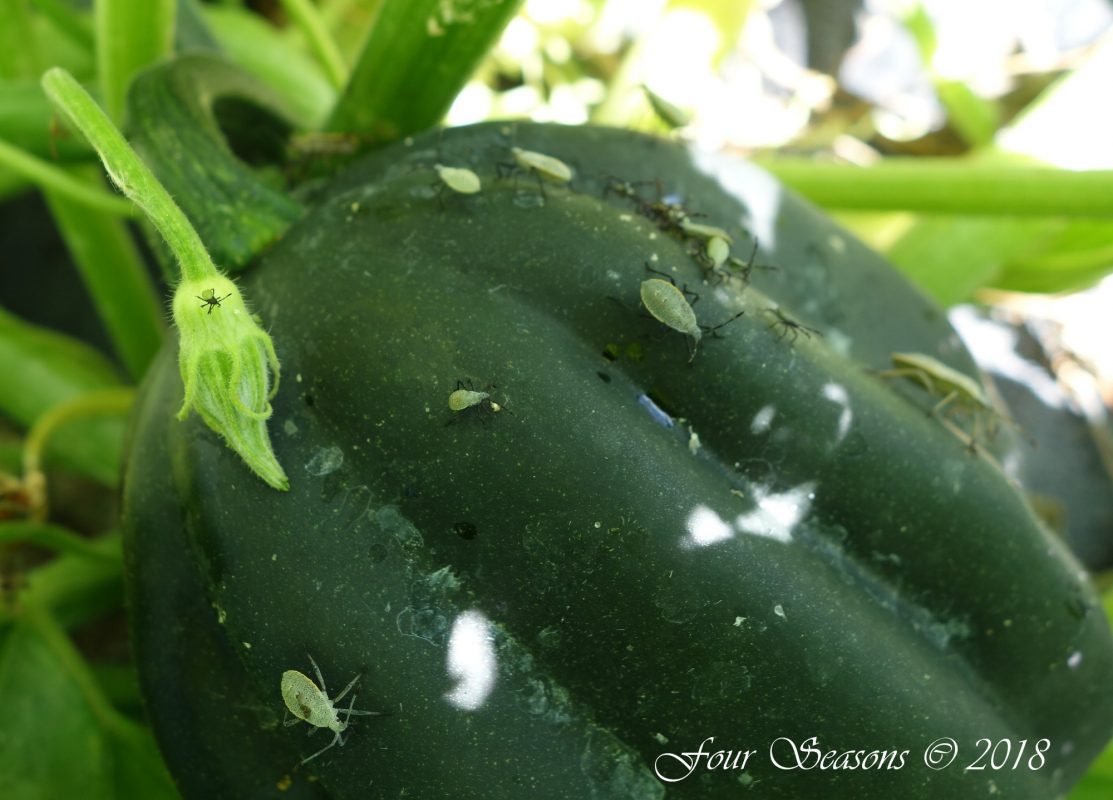Right about now you should be finding a bumper crop of squash in your garden. Zucchini, yellow, scalloped, crookneck, spaghetti, butternut and more all make for delicious meals from now through the winter. Unfortunately, there are others who think this summer bounty makes a fine meal as well and those are the squash bugs that accompany them.
If you’ve ever planted squash you most likely know what squash bugs are. Squash bugs are easily spotted because they will congregate and reproduce on just about anything in the cucurbit family which means all squash, cucumbers and sometimes pumpkins. They are easily identified because they are fairly large with a brownish or grey body. They have a flat back that is somewhat triangle shaped. They are fairly large and tend to be ½” long (or more) and about 1/3″ wide. Juveniles are usually light green or grey. Most often you will see them simply walking around on your plants but they can fly.
They are relentless and persistent and can be very difficult to get rid of once a population has infested your garden but it’s important to deal with them as soon as they are spotted. Squash bugs cause damage to a crop when the bug injects a toxin into the plant as it sucks the sap out. The first signs of damage you will most likely see is yellow spots or yellowing of leaves. Eventually they turn brown and wilt since the damage that the bugs have done will prevent the plant from getting nutrients. This will cause them to dry up and become brittle.
The damage is similar, and often confused, with the damage that is caused by cucumber beetles, but the difference is that while the cucumber beetles spread bacterial wilt, squash bugs do not.
Early detections is the key in controlling and eliminating them from your garden. Once squash bugs appear, controlling them is an ongoing task but here are several things to try. One of the easiest things to do is to delay planting your squash until early in the summer or keep your young plants covered for a while after planting until they begin to bloom. Since there is usually only one generation of squash bugs per season, the longer you can delay their arrival, the better for your plants.
If they appear and there aren’t too many, simply pick them off by hand and squash them. But be careful- when squashed they do have a nasty odor similar to stinkbugs. If there are eggs on the underside of the leaves, scrape those off and destroy them as well.
If your population is larger than what you can pick by hand, try putting an old board out in the garden in the evening. These bugs love old wood and they will congregate under them. Simply remove the board in the morning and you can easily destroy what has gathered there. This is a better way to kill a larger number at once time than hand squashing.
Food grade diatomaceous earth is something else to try. This powder consists of finely ground diatoms that will slice the body of the bugs as they crawl over it. However, there are two downsides to this method. First, it is usually effective only on the young bugs, but it will help to reduce the population, and the second is that it can also harm other beneficial insects in your garden as well.
Companion planting with nasturtiums has been known to help and you also can try your favorite natural bug spray made at home. Unfortunately, since they are pretty prolific little fellows, these are often ineffective on a large scale infestation.
If you are unfortunate enough to have that large infestation, you can also try a chemical control. The gardeners old friend Sevin or the newer Eight from Bonide are both good products to try. These preparations have been around a long time and although you should always follow label directions, in many crops, they are safe to use up until right before you harvest. If the fairly mild Sevin or Eight don’t help in knocking the infestation back, then you can move on to more potent chemical controls, just be sure the particular preparation you use is labeled for this purpose.
Be sure to remove plant debris throughout the growing season to reduce the attractiveness of your garden for these pests.
Control of these pests actually begins before the crop is even planted since they can overwinter so prevention is key. Here are some things to bear in mind as your garden winds down this summer in order to prevent or decrease the infestation next year.
In the fall be sure to remove any remaining plant material from your garden, particularly squash plants. Burn it if possible in order to destroy any eggs left behind and remove a welcoming habitat in which they can shelter or overwinter and breed come the following spring. Avoid thick mulch that will provide a deep, cool place for them to hide. These bugs love things like hay and straw so keep them out of your garden if possible.
Squash is personally one of my favorite vegetables, so for me the delicious delight that is fresh squash is worth the battle of the bugs. With a little persistence and prevention, you can win the squash bug battle too!

